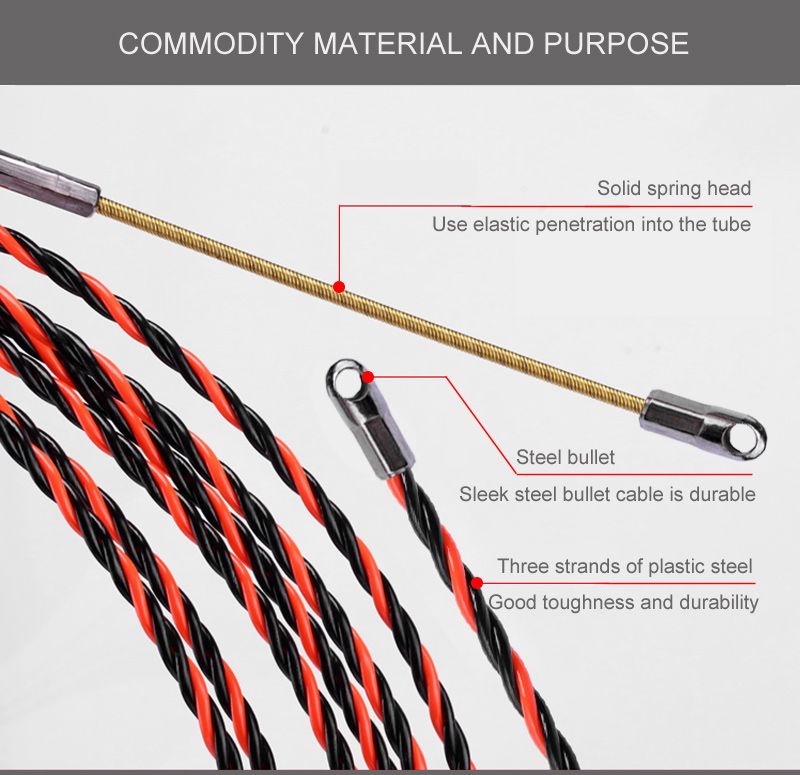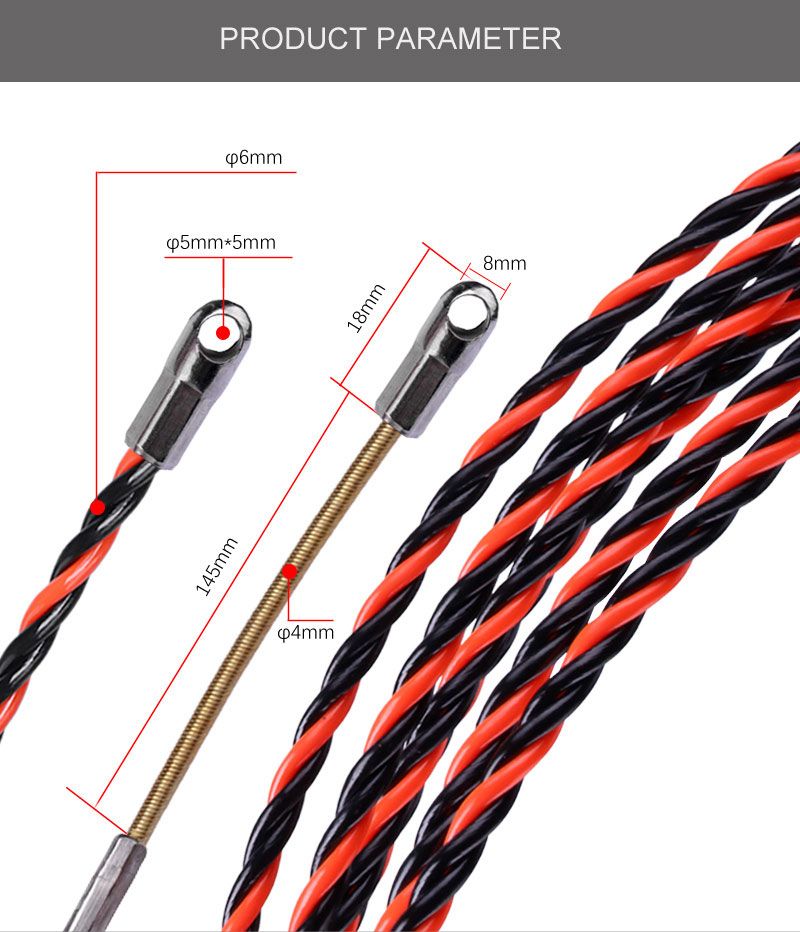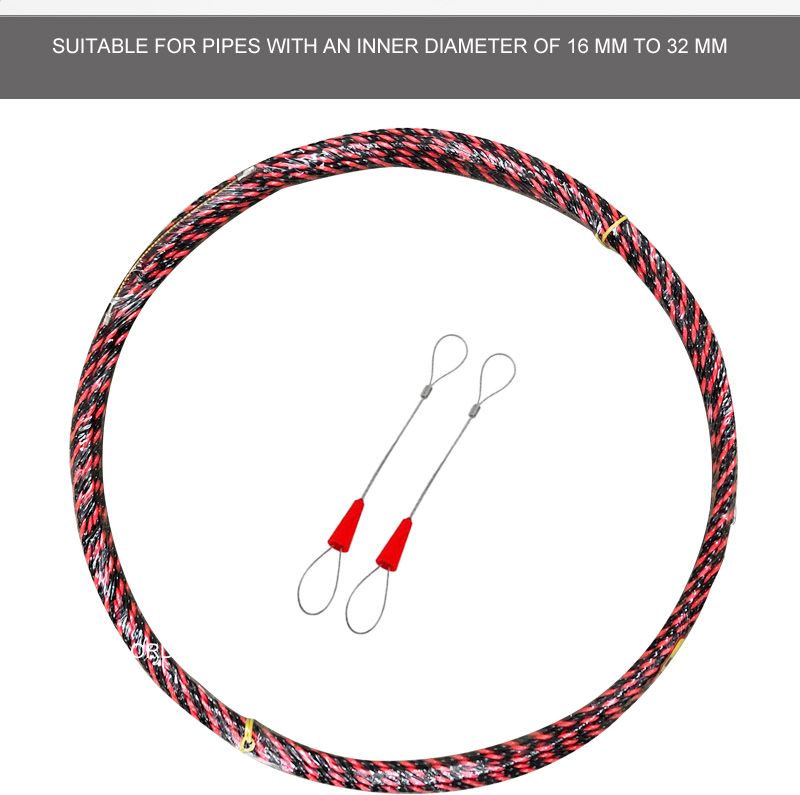You can make electrical work easier and faster with fish tape. This tool lets you pull wires through walls, ceilings, or conduits without making big holes. You save time and effort. Your wiring projects look cleaner. Fish tape helps both professionals and DIYers finish jobs with less mess.
Key Takeaways
- Fish tape helps pull wires through walls and tight spaces quickly without making big holes, saving time and effort.
- The strong, flexible 3-core PET fish tape bends around corners and resists breaking, making wiring jobs easier and cleaner.
- Using fish tape reduces wall damage, speeds up installation, and keeps your work area neat and safe.
Fish Tape: Essential Tool for Efficient Wiring
What Is Fish Tape and How It Works
You use fish tape to pull wires through walls, ceilings, and conduits. This tool looks like a long, flexible strip made from strong materials. You push the tape through a tight space until it reaches the other side. Then, you attach your wire to the end of the tape. When you pull the tape back, it brings the wire with it. This process helps you move wires through places your hands cannot reach.
The 100% NEW PET 3 Core PET Fish Tape uses a special three-strand design. This design gives you both strength and flexibility. The tape can bend around corners and go through narrow spaces. The bright red color makes it easy to see, even in dark areas. You can choose different lengths and thicknesses to fit your job.
Key Benefits for Electrical Installation Efficiency
Fish tape saves you time and effort. You do not need to cut large holes in walls or ceilings. You avoid extra repairs and keep your work area clean. The strong PET material resists breaking, so you can trust it for tough jobs. The lightweight design makes it easy to handle, even for long pulls.
Tip: Use fish tape when you need to run wires for lights, outlets, or security systems. You will finish your projects faster and with less mess.
You can use fish tape for many types of wiring, from home repairs to big building projects. This tool helps you work smarter, not harder.
How Fish Tape Streamlines the Installation Process
Navigating Tight Spaces and Complex Paths
You often face tight spaces and tricky paths when installing electrical wires. Fish tape helps you reach places that your hands cannot. You push the tape through small holes, around corners, and inside conduits. The flexible tip lets you guide the tape through sharp bends without getting stuck.
The 100% NEW PET 3 Core PET Fish Tape stands out because of its three-strand design. This design gives you the right mix of strength and flexibility. You can move the tape through complex routes in walls, ceilings, or floors. The bright red color helps you see the tape in dark or crowded spaces.
Tip: Shine a flashlight on the red tape to spot it quickly in low-light areas.
Reducing Labor and Installation Time
You save a lot of time when you use fish tape. You do not need to open large sections of walls or ceilings. You push the tape through, attach the wire, and pull it back. This process takes only a few minutes for most jobs.
Here is how fish tape helps you work faster:
- You avoid extra steps like patching holes or cleaning up debris.
- You spend less time searching for lost wires inside walls.
- You finish more jobs in a single day.
| Task | With Fish Tape | Without Fish Tape |
|---|---|---|
| Pulling wire through conduit | Fast | Slow |
| Wall damage | Minimal | High |
| Cleanup needed | Low | High |
You can see that fish tape makes each step easier and quicker.
Minimizing Wall and Surface Damage
You want your work area to stay neat. Fish tape lets you pull wires without cutting big holes or damaging surfaces. You only need small entry and exit points. The tape glides smoothly through conduits and behind walls.
The 100% NEW PET 3 Core PET Fish Tape resists breaking and keeps its shape. You do not have to worry about the tape snapping or bending out of shape. This means you avoid extra repairs and keep the building looking good.
Note: Using fish tape helps you protect painted walls, wallpaper, and finished ceilings.
You get a cleaner result and spend less time fixing damage after the job.
 |
 |
 |
Using Fish Tape Effectively and Safely
Step-by-Step Guide to Using Fish Tape
You can use fish tape to pull wires through walls, ceilings, or conduits with ease. Follow these steps for a smooth installation:
- Prepare the Area
Turn off the power to the area where you will work. Gather your tools and make sure you have enough light. - Insert the Fish Tape
Push the end of the fish tape into the entry point. Guide it through the conduit or wall cavity. Keep a steady hand and move slowly to avoid snags. - Attach the Wire
When the tape reaches the exit point, strip a small section of the wire. Thread the wire through the hole at the end of the tape. Wrap the wire securely with electrical tape to keep it from slipping. - Pull the Wire Through
Go back to the entry point. Gently pull the tape back, bringing the wire with it. Move slowly and check for resistance. If you feel a snag, stop and adjust. - Finish the Job
Once the wire comes through, disconnect it from the tape. Complete your wiring connections and restore power.
Tip: Always double-check your connections before turning the power back on.
Tips for Overcoming Common Challenges
You may face some problems when using fish tape. Here are some tips to help you:
- Getting Stuck in Bends
If the tape gets stuck, pull it back a little and try again. Twist the tape gently to help it move around corners. - Wire Slips Off the Tape
Use extra electrical tape to secure the wire. Make sure the connection is tight before pulling. - Hard to See the Tape
Shine a flashlight into the wall or conduit. The bright red color of the 100% NEW PET 3 Core PET Fish Tape makes it easier to spot. - Long Distances
For long pulls, ask a friend to help. One person can guide the tape while the other pulls the wire.
| Challenge | Solution |
|---|---|
| Tape gets stuck | Pull back, twist, try again |
| Wire slips off | Use more electrical tape |
| Hard to see tape | Use a flashlight |
| Long wire runs | Get help from another person |
Note: Patience and careful movements help you avoid most problems.
Safety and Best Practices
You should always put safety first when working with electrical tools. Follow these best practices:
- Turn off the power before you start.
- Wear safety glasses and gloves to protect yourself.
- Check the area for sharp edges or nails before inserting the tape.
- Keep your workspace clean and free of clutter.
- Store your fish tape in a dry place after use.
Never use fish tape near live wires. Electricity can travel through the tape and cause injury.
You can work faster and safer when you follow these steps. Practice makes you better at using fish tape for all your wiring projects.
You can make your electrical projects faster and safer with the right tools. Fish tape helps you avoid damage and finish jobs quickly. You save time and effort. Whether you work as a professional or do it yourself, you get clean results and a smoother installation process.
FAQ
How do you choose the right length of fish tape?
You pick a length based on your project. Shorter tapes work for small jobs. Longer tapes help you reach wires in bigger spaces.
Tip: Measure the distance before you start.
Can you use fish tape for more than electrical wiring?
Yes, you can. You use fish tape for telephone lines, internet cables, and even TV coax cables. It works for many types of wires.
What should you do if the fish tape gets stuck?
You stop pulling. Gently twist the tape and push it back a little. Try again. If it stays stuck, check for sharp bends or blockages.
Post time: Jul-02-2025







